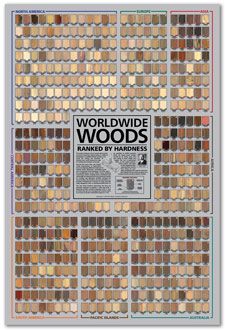n the world of acoustic guitars, perhaps no other tonewood holds the same respect and downright mystique as Brazilian Rosewood (Dalbergia nigra). Yet paradoxically, the wood has been virtually loved to death: since 1992, it’s been on the CITES Appendix I, the most restrictive category of endangered species, (even finished products may not cross international borders). Because of these protective measures, several substitutes have been used in recent years, primarily East Indian Rosewood (Dalbergia latifolia). Hence, for a multitude of reasons, differentiating between true Brazilian Rosewood and many of its close cousins can be very useful.
| BRAZILIAN ROSEWOOD | vs | EAST INDIAN ROSEWOOD |
| Brazilian Rosewood (Dalbergia nigra) | East Indian Rosewood (Dalbergia latifolia) | |
| Color: Tends to be more variegated, and more on the reddish side. (Can also exhibit a figure in the grain similar to Ziricote that is known as “spider-webbing.” | Color: Tends to be a dark chocolate or purplish brown. | |
| Average Weight: 52 lbs/ft3 (835 kg/m3) The two weights are so close, for all intents and purposes, density is identical. | Average Weight: 52 lbs/ft3 (830 kg/m3) The two weights are so close, for all intents and purposes, density is identical. | |
| Scent: Has a distinct, rose-like scent when being worked. | Scent: Has a distinct, rose-like scent when being worked; some find its scent less pleasant than other Dalbergia rosewoods. | |
| Brazilian Rosewood (endgrain 10x) | East Indian Rosewood (endgrain 10x) |
Endgrain: Pay close attention to the endgrain, as it’s one of the best ways to separate the two woods. Each sample above represents approximately a 3/8″ square section of endgrain. The key is in the pore density: East Indian Rosewood has about twice as many pores per square inch as Brazilian Rosewood. This can be difficult to gauge if you don’t have any known samples to compare, but Brazilian Rosewood should have fairly sparsely spaced pores, while East Indian Rosewood should be almost riddled with pores.
ANOTHER USEFUL TRICK
Apart from the very characteristic odor, (which should roughly separate it from most non-Dalbergia species), Brazilian Rosewood has another characteristic that can be leveraged in order to help distinguish it from other rosewoods: its heartwood extractives are not water soluble, and will not fluoresce under a blacklight.
Before you get scared off from performing this test, be aware that with a simple blacklight bulb available in any hardware store for only a few dollars, and a few minutes of your time, you can perform both water extract fluorescence and ethanol extract fluorescence tests at home!
For suspected samples of Brazilian Rosewood, take a small test tube or other small transparent container and fill it with some shavings, (a handplane works great for this), and then fill the remainder of the container with water and shake it up for a few seconds. Bring the container under the blacklight and observe the results: true Brazilian Rosewood (Dalbergia nigra) will not fluoresce or show any appreciable change of color under the blacklight, while most other rosewoods will glow a pale blue/green color.
TELLING BRAZILIAN ROSEWOOD APART FROM OTHER COMMON SUBSTITUTES:
Non-Dalbergias: Use scent to rule out most non-Dalbergia species. (Scents are difficult to describe in words, but certainly no scent at all would be a negative sign.)
East Indian Rosewood: Pore density; water extract fluorescence
Amazon Rosewood: Density—Amazon Rosewood tends to sink in water; water extract fluorescence
Madagascar Rosewood: Water extract fluorescence
Cocobolo: Density—Cocobolo tends to sink in water; water extract fluorescence
Kingwood: Density—Kingwood tends to sink in water; pore size—Kingwood’s pores tend to be smaller; water extract fluorescence
Honduran Rosewood: Density—Honduran Rosewood may not sink in water, but it is roughly 20% heavier; pore size—Honduran Rosewood has slightly varying sizes of pores (ranging from medium-small to large); water extract fluorescence
ARE YOU AN ASPIRING WOOD NERD?
The poster, Worldwide Woods, Ranked by Hardness, should be required reading for anyone enrolled in the school of wood nerdery. I have amassed over 500 wood species on a single poster, arranged into eight major geographic regions, with each wood sorted and ranked according to its Janka hardness. Each wood has been meticulously documented and photographed, listed with its Janka hardness value (in lbf) and geographic and global hardness rankings. Consider this: the venerable Red Oak (Quercus rubra) sits at only #33 in North America and #278 worldwide for hardness! Aspiring wood nerds be advised: your syllabus may be calling for Worldwide Woods as part of your next assignment!


